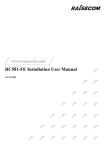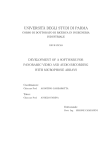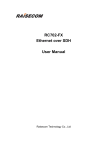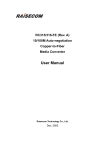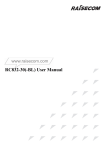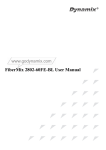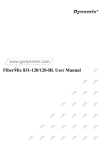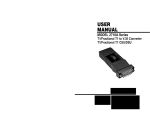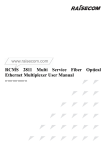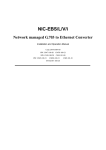Download RC552-FE (A) User Manual
Transcript
www.raisecom.com RC552-FE (A) User Manual May, 2006 Legal Notices Raisecom Technology Co., Ltd makes no warranty of any kind with regard to this manual, including, but not limited to, the implied warranties of merchantability and fitness for a particular purpose. Raisecom Technology Co., Ltd shall not be held liable for errors contained herein or direct, indirect, special, incidental or consequential damages in connection with the furnishing, performance, or use of this material. Warranty. A copy of the specific warranty terms applicable to your Raisecom product and replacement parts can be obtained from Service Office. Restricted Rights Legend. All rights are reserved. No part of this document may be photocopied, reproduced, or translated to another language without the prior written consent of Raisecom Technology Co., Ltd. The information contained in this document is subject to change without notice. Copyright Notices. Copyright ©2006 Raisecom. All rights reserved. No part of this publication may be excerpted, reproduced, translated or utilized in any form or by any means, electronic or mechanical, including photocopying and microfilm, without permission in Writing from Raisecom Technology Co., Ltd. Trademark Notices is the trademark of Raisecom Technology Co., Ltd. Java™ is a U.S. trademark of Sun Microsystems, Inc. Microsoft® is a U.S. registered trademark of Microsoft Corporation. Windows NT® is a U.S. registered trademark of Microsoft Corporation. Windows® 2000 is a U.S. registered trademark of Microsoft Corporation. Windows® XP is a U.S. registered trademark of Microsoft Corporation. Windows® and MS Windows® are U.S. registered trademarks of Microsoft Corporation. Contact Information Technical Assistance Center The Raisecom TAC is available to all customers who need technical assistance with a Raisecom product, technology, or, solution. You can communicate with us through the following methods: Add: 1120, Haitai Tower, 229 Fourth North Loop Middle Road, Haidian District, Beijing 100083 Tel: Fax: +86-10-82884499 Ext.878 (International Department) +86-10-82885200, +86-10-82884411 World Wide Web You can access the most current Raisecom product information on the World Wide Web at the following URL: http://www.raisecom.com Feedback Comments and questions about how the NView iEMS system software works are welcomed. Please review the FAQ in the related manual, and if your question is not covered, send email by using the following web page: http://www.raisecom.com/en/xcontactus/contactus.htm. If you have comments on the NView iEMS specification, instead of the web page above, please send comments to: [email protected] We hope to hear from you! CONTENTS CHAPTER 1 PREFACE ........................................................................................................................................................5 CHAPTER 2 PRODUCT OVERVIEW................................................................................................................................7 CHAPTER 3 TECHNICAL SPECIFICATION ..................................................................................................................8 2.1 BASIC SPECIFICATION ...........................................................................................................................................................8 2.2 OPTICAL INTERFACE SPECIFICATION.....................................................................................................................................8 CHAPTER 4 INSTALLATION PREPARATION AND CONNECTION .........................................................................9 3.1 MATCHING FIBER WITH THE MEDIA CONVERTER ..................................................................................................................9 3.2 FIBER OPTIC TYPES ...............................................................................................................................................................9 3.3 CONNECTING THE FIBER INTERFACE OF MEDIA CONVERTER ................................................................................................9 3.4 BACK-TO-BACK CONNECTING MEDIA CONVERTERS .............................................................................................................9 3.5 CONNECTING MEDIA CONVERTERS TO ETHERNET DEVICES (UTP INTERFACE)..................................................................10 3.6 INSTALLING THE MODULE (IN CHASSIS) ONTO THE RACK ...................................................................................................10 3.7 INSTALLING WITH DC POWER SUPPLY ................................................................................................................................10 3.8 ELIGIBLE POWER SUPPLY....................................................................................................................................................11 CHAPTER 5 STATUS INDICATORS................................................................................................................................12 4.1 THE FRONT PANEL OF RC552-FE(A) ..................................................................................................................................12 4.2 THE INDICATORS OF RC552-FE(A).....................................................................................................................................12 4.3 THE INDICATORS OF 16-SLOT CHASSIS ................................................................................................................................12 CHAPTER 6 DEVICE SETUP ...........................................................................................................................................13 5.1 COPPER INTERFACE CONFIGURATION DIP-SWITCH SW20 ..................................................................................................13 5.2 FUNCTION CONFIGURATION DIP-SWITCH SW21.................................................................................................................13 5.3 FIBER INTERFACE CONFIGURATION DIP-SWITCH SW22......................................................................................................14 CHAPTER 7 NETWORK MANAGEMENT FEATURES...............................................................................................15 6.1 REVIEW THE MODULE .........................................................................................................................................................15 6.2 CONFIGURE THE MODULE ...................................................................................................................................................15 6.3 LOOPBACK TEST .................................................................................................................................................................16 6.4 RESET THE MODULE............................................................................................................................................................16 CHAPTER 8 CONFIGURE AND MANAGE RC552-FE(A) THROUGH CLI..............................................................17 7.1 MENU INTRODUCTION .........................................................................................................................................................17 7.2 CONFIGURE RC552-FE(A) THROUGH CONSOLE .................................................................................................................17 7.2.1 Login ...........................................................................................................................................................................17 7.2.2 Display the Module Status...........................................................................................................................................18 7.2.3 Configure the Module Loopback.................................................................................................................................18 7.2.4 Display the Module Fault Propagation Status ............................................................................................................19 7.2.5 FPGA Firmware Online Upgrade...............................................................................................................................20 7.2.6 Exit the Console ..........................................................................................................................................................22 CHAPTER 9 IEEE802.3AH OAM FUNCTIONS .............................................................................................................23 8.1 OVERVIEW ..........................................................................................................................................................................23 8.2 OAM DISCOVERY ...............................................................................................................................................................23 8.3 MIB VARIABLE REPLY ........................................................................................................................................................23 8.4 LOOPBACK ..........................................................................................................................................................................23 8.5 DYING GASP ALARM ...........................................................................................................................................................23 APPENDIX A. FAQ ...................................................................................................................................................................24 Chapter 1 Preface About This Manual This manual introduces primary functions of the configuration management software for RC series products. Who Should Read This Manual Sales and marketing engineers, after service staff and telecommunication network design engineers could use this manual as a valuable reference. If you want to get an overview on features, applications, architectures and specifications of Raisecom RC series integrated access devices, you could find useful information in this manual as well. Compliance The RC series products developed by Raisecom are strictly complied with the following standards as well as ITU-T, IEEE, IETF and related standards from other international telecommunication standard organizations: YD/T900-1997 SDH Equipment Technical Requirements - Clock YD/T973-1998 SDH 155Mb/s and 622Mb/s Technical conditions of optical transmitter module and receiver module YD/T1017-1999 Network node interface for the Synchronous Digital Hierarchy (SDH) YD/T1022-1999 Requirement of synchronous digital hierarchy (SDH) equipment function YD/T1078-2000 SDH Transmission Network Technique Requirements-Interworking of Network Protection Architectures YD/T1111.1-2001 Technical Requirements of SDH Optical Transmitter/Optical Receiver Modules——2.488320 Gb/s Optical Receiver Modules YD/T1111.2- 2001 Technical Requirements of SHD Optical Transmitter/Optical Receiver Modules——2.488320 Gb/s Optical Transmitter Modules YD/T1179- 2002 Technical Specification of Ethernet over SDH G.703 Physical/electrical characteristics of hierarchical digital interfaces G.704 Synchronous frame structures used at 1544, 6312, 2048, 8448 and 44 736 kbit/s hierarchical levels G.707 Network node interface for the synchronous digital hierarchy (SDH) G.774 Synchronous digital hierarchy (SDH) - Management information model for the network element view G.781 Synchronization layer functions G.783 Characteristics of synchronous digital hierarchy (SDH) equipment functional blocks G.784 Synchronous digital hierarchy (SDH) management G.803 Architecture of transport networks based on the synchronous digital hierarchy (SDH) G.813 Timing characteristics of SDH equipment slave clocks (SEC) G.823 The control of jitter and wander within digital networks which are based on the 2048 kbit/s hierarchy G.825 The control of jitter and wander within digital networks which are based on the synchronous digital hierarchy (SDH) G.826 End-to-end error performance parameters and objectives for international, constant bit-rate digital paths and connections G.828 Error performance parameters and objectives for international, constant bit-rate synchronous digital paths G.829 Error performance events for SDH multiplex and regenerator sections G.831 Management capabilities of transport networks based on the synchronous digital hierarchy (SDH) G.841 Types and characteristics of SDH network protection architectures G.842 Interworking of SDH network protection architectures G.957 Optical interfaces for equipments and systems relating to the synchronous digital hierarchy G.691 Optical interfaces for single channel STM-64 and other SDH systems with optical amplifiers G.664 Optical safety procedures and requirements for optical transport systems I.731 ATM Types and general characteristics of ATM equipment I.732 ATM Functional characteristics of ATM equipment IEEE 802.1Q Virtual Local Area Networks (LANs) IEEE 802.1p Traffic Class Expediting and Dynamic Multicast Filtering IEEE 802.3 CSMA/CD Access Method and Physical Layer Instruction Chapter 2 Product Overview RC552-FE(A) remote-manageable, bandwidth controllable, and 10/100M auto-sensing Ethernet Media Converter is Raisecom’s self-developed IEEE802.3ah OAM-capable module, which implements Ethernet signal electrical-optical conversion. RC552-FE(A) module can be inserted into Raisecom’s 3U 16-slot chassis, coexisting with other RC series media converters; and also can be inserted into single slot chassis to act as a standalone device. When deployed with remote network management, RC552-FE(A) has two working modes: Master and Slave. The module at central office shall work at Master mode, while the module at customer premise shall work at Slave mode. The Master module will originate network management and manage the Slave module. When working at Slave mode, 4 standard OAM functions are supported. They are OAM discovery, MIB variable request respond, Loopback, and Dying Gasp alarm indication. Page 7 of 25 Chapter 3 Technical Specification 2.1 Basic Specification Dimensions (height×width×depth) Optical interface Working temperature (℃) Storage temperature (℃) Power consumption (W) Working humidity 25mm×91mm×172mm 1x9 0~45℃ -40~80℃ <5W 5%~90% non condensing 2.2 Optical Interface Specification Optical Interface Model Type Working wavelength nm Launch power RJ45 UTP Interface dBmW Receiving sensitivity dBmW Receiving saturation dBmW Distance (Km) Optical loss dB/Km -M DSC 1310 -18 ~ -14 -31 -14 0~2 3 -S1 DSC 1310 -15 ~ -8 -31 -8 0 ~ 25 0.5 -S2 DSC 1310 -5 ~ -0 -35 -3 10 ~ 60 0.5 -S3 DSC 1550/DFB -5 ~ -0 -35 -3 15 ~ 120 0.25 -SS13 SC 1310/1550 -15 ~ -8 -31 -8 0 ~ 25 0.5 -SS15 SC 1550/1310 -11 ~ -5 -31 -5 0 ~ 25 0.5 -SS23 SC 1310/1550 -5 ~ 0 -35 -3 10 ~ 60 0.5 -SS25 SC 1550/1310 -5 ~ 0 -35 -3 10 ~ 60 0.5 Speed 10/100M Duplex mode Auto configurable Auto configurable Auto configurable Auto configurable Auto configurable Auto configurable Auto configurable Auto configurable Auto configurable Auto configurable Auto configurable Auto configurable Auto configurable Auto configurable Auto configurable Auto configurable MDI /MDIX Yes Yes Yes Yes Yes Yes Yes Yes Note: the transmission distance is the maximum distance that can be reached in circumstance of typical fiber optics. The actual distance depends on the actual network environment. Page 8 of 25 Chapter 4 Installation Preparation and Connection 3.1 Matching Fiber with the Media Converter RC552-FE(A)-M shall be connected with multimode fiber media and DSC optical connector. RC552-FE(A)-S1/2/3 shall be connected with single-mode fiber media and DSC optical connector. RC552-FE(A)-SS13/SS15/SS23/SS25 shall be connected with single-mode single-strand fiber media and SC/PC optical connector. 3.2 Fiber Optic Types The fiber optic for multimode interface shall be 62.5/125um or 50/125um multimode fiber. The fiber optic for single-mode interface shall be 9/125um single-mode fiber. 3.3 Connecting the Fiber Interface of Media Converter The following 5 conditions shall be met before connecting the fiber interface: 1. Matching the wavelengths. Especially when connecting single-strand fiber interface, make sure the two media converters are using 1310nm and 1550nm transmit wavelengths respectively. For example, media converter A transmits at 1310nm and receives at 1550nm; then media converter B transmits at 1550nm and receives at 1310nm. 2. Matching the speed of optical interface. They shall have the same speed. 3. Matching the optical power. 4. Compliant with IEEE802.3-2000 standard. 3.4 Back-to-back Connecting Media Converters When back-to-back connecting media converters, the rules mentioned in 3.3 Connecting the Fiber Interface of Media Converter must be followed. Regarding to RC552-FE media converter, it is recommended to follow the table below. (if the connecting rules in below table cannot be met, please disable remote management function) Central Office Site Customer Premise Site RC552-FE(A)-M-Master RC552-FE(A)-M-Slave RC552-FE(A)-S1-Master RC552-FE(A)-S1-Slave RC552-FE(A)-S2-Master RC552-FE(A)-S2-Slave RC552-FE(A)-S3-Master RC552-FE(A)-S3-Slave RC552-FE(A)-SS15-Master RC552-FE(A)-SS13-Slave Page 9 of 25 RC552-FE(A)-SS25-Master RC552-FE(A)-SS23-Slave 3.5 Connecting Media Converters to Ethernet Devices (UTP Interface) When connecting media converters to other Ethernet devices, please pay attention that the length of UTP cable cannot exceed 100 meters. 1. 2. When the UTP interface is at auto-negotiation status, auto-MDI/MDIX function is also enabled in the mean time. Either straight-through or crossover cable can be used to connecting other Ethernet device. Media converter Other Ethernet Device Media converter Switch Media converter HUB Media converter Router Media converter Network interface card UTP Interface Straight-through, crossover Straight-through, crossover Crossover, straight-through Crossover, straight-through When the UTP interface is at manual configuration status, auto-MDI/MDIX function is disabled and the following connecting rules must be followed. Media converter Media converter Media converter Media converter Media converter Other Ethernet Device Switch HUB Router Network interface card 3.6 Installing the Module (in Chassis) onto the Rack UTP Interface Straight-through Straight-through Crossover Crossover 19"标准机架 The fixing accessories of chassis are in the accessory box. If fixing the chassis with the rear hole, there’ll be 3 cm more space between the front edge of chassis and the rack; if fixing with the front hole, there’ll be 3cm less space. 3.7 Installing with DC Power Supply DC power supply provides three connecters: –48V, ground and 0V. These three connecters are connected respectively with –48V power cable, ground protection and 0V power cable. Page 10 of 25 3.8 Eligible Power Supply AC: 220V/50Hz DC: -48V Page 11 of 25 Chapter 5 Status Indicators 4.1 The Front Panel of RC552-FE(A) The sketch of front panel of RC552-FE(A): Optical Signal Action Electrical Signal Action Optical Signal Detection Remote Equipment Power Supply 4.2 The Indicators of RC552-FE(A) RC552-FE(A) module’s indicators and their indications are as follows. Port Fiber Name Indicator Optical receiving signal SD detection Optical receiving action ACK Remote equipment OAM Copper link/signal action LNK/ACT Copper link speed 100M Duplex mode/collision FDX Power supply PWR Copper Power Explanation ON: optical signal is detected at receiving link; OFF: receiving link failure FLASHING: optical signals are transmitted/received ON: remote OAM capable equipment is detected; OFF: no remote OAM capable equipment is detected. ON: copper link is normal; OFF: copper link failure; FLASHING: electrical signals are transmiited/received ON: copper link speed is 100M; OFF: copper link speed is 10M. ON: copper link is in full duplex mode; OFF: copper link is in half duplex mode; FLASHING: collision is detected at half duplex mode. ON: power supply is normal; OFF: power supply failure. 4.3 The Indicators of 16-slot Chassis The 16-slot chassis’ indicators and their indications are as follows. PWR indicator: ON, power supply of chassis is normal. PS1-5V indicator: OFF, Power Supply 1 is normal, otherwise failure. PS2-5V indicator: OFF, Power Supply 2 is normal, otherwise failure. Page 12 of 25 Chapter 6 Device Setup There are 3 setup DIP-switches on RC552-FE(A) module, including function configuration DIP-switch SW21, copper interface configuration DIP-switch SW20, and fiber interface configuration DIP-switch SW22. 5.1 Copper Interface Configuration DIP-switch SW20 SW20 is a 4-bit DIP-switch, including auto-negotiation enable/disable, speed 100M/10M, and full/half duplex mode. Switch 1 2 Meaning Auto-negotiation enable/disable Speed configuration Status Configuration introduction ON Copper interface manual configuration OFF Copper interface auto-negotiation ON Manually set to 10M OFF Manually set to 100M ON 3 Duplex mode configuration OFF 4 Manually set to half duplex mode; if auto-negotiation fails, work at half duplex mode Manually set to full duplex mode; if auto-negotiation fails, work at full duplex mode Reserved Note 1: if 1st bit of SW20 is set to OFF, 2nd bit will be invalid. Note 2: the default status of SW20 is all OFF. 5.2 Function Configuration DIP-switch SW21 SW21 is an 8-bit DIP-switch, including MASTER/SLAVE, reserved, reserved, reserved, ALS, fiber interface to copper interface fault propagation disable/enable, and copper interface to fiber interface fault propagation disable/enable. Switch Meaning Status ON, ON 1 Working mode configuration ON, OFF OFF, ON 2 OFF, OFF 3 4 5 Configuration introduction OAM function is disabled. (if inserted into 16-slot chassis, it is indicated as SLAVE module; if used as remote module, it cannot be managed) MASTER mode (can be managed as central office module) SLAVE mode (can be managed as remote module) Reserved Reserved Reserved Reserved Page 13 of 25 6 Fiber interface ALS disable/enable ON OFF 7 Fiber interface to copper interface fault propagation disable/enable ON OFF 8 Copper interface to fiber interface fault propagation disable/enable ON OFF If no receiving optical signal is detected, shut down the fiber interface. Note: this function only takes effect when OAM is disabled. ALS function is disabled. If no receiving optical signal is detected, shut down local copper interface; if remote module has enabled copper interface to fiber interface fault propagation and no electrical signal is detected, shut down local copper interface. Disable fiber interface to copper interface fault propagation function. If no electrical signal is detected, shut down local fiber interface. Note: this function only takes effect when OAM is disabled or the device cannot be remotely managed. Disable copper interface to fiber interface fault propagation function. Note 1: by default, the 1st and 2nd bits of SW21 are OFF and ON respectively, others all OFF. 5.3 Fiber Interface Configuration DIP-switch SW22 SW22 is used to configure the fiber interface type. It represents the fiber interface properties and is configured properly before shipping to customers. Customers must not change the status of this DIP-switch. Page 14 of 25 Chapter 7 Network Management Features 6.1 Review the Module When RC552-FE(A) module is inserted into 16-slot chassis with management agent card, customers can review the module status and also configure the module. The following parameters can be reviewed or configured. Number Name of configurable item Value 1 Module type 2 Remote management (MASTER only) Enable/disable 3 4 Module voltage exceeds upper threshold (SLAVE only) Module voltage exceeds lower threshold (SLAVE only) M/S1/S2/S3 Attribute Uncontrollable, non-configurable Configurable Normal, up overflow Uncontrollable, non-configurable Normal, low overflow Uncontrollable, non-configurable 5 Module temperature (SLAVE only) Actual temperature Uncontrollable, non-configurable 6 Remote module power off indication (MASTER only) Normal, power off Uncontrollable, non-configurable 7 Maximum transmission unit 1916Byte, 1536Byte Configurable 8 Bandwidth management N × 32Kb/s ‘N’ is configurable 9 Fiber interface inside loopback Start, finish Configurable 10 Fiber interface outside loopback Start, finish Configurable 11 Loopback parameter Exchange MAC address, Configurable non-exchange MAC address 12 13 Fiber interface to copper interface fault Enable, disable propagation Copper interface to fiber interface fault Enable, disable propagation Configurable Configurable 14 Fiber interface ALS Enable, disable Configurable 15 Copper interface: link status Up, down Uncontrollable, non-configurable 17 Copper interface: auto-negotiable Enable, manual Configurable 18 Copper interface: control Enable, disable Configurable 19 Copper interface: duplex mode Full duplex, half duplex Configurable 20 Copper interface: speed 10M, 100M Configurable 21 Fiber interface: transmit link Up, Down Uncontrollable, non-configurable 22 Fiber interface: receive link Up, Down Uncontrollable, non-configurable 23 Fiber interface: signal Normal, abnormal Uncontrollable, non-configurable Note: all configurable items of SLAVE module can only be set through MASTER module; only SLAVE module status can be reviewed locally. 6.2 Configure the Module In the above table, all configurable items can be set through ‘config module’ command in NMS. These items include copper Page 15 of 25 interface speed, fault propagation, and etc. However, SLAVE module cannot be configured locally, buy only remotely through MASTER module. That is to say, if SLAVE module is inserted into 16-slot chassis with management card, customers will only be able to review its status rather than to configure it. 6.3 Loopback Test For central office module, customers can enable or disable loopback test through ‘module loopback test’ command, and view the result through ‘show module’ command. CO module inside loopback: Packets sent from CO copper interface will be looped inside CO module and received/discard by CO copper interface Remote module outside loopback: Packets sent from CO copper interface will be looped at remote module and received/discard by CO copper interface CO Remote TP FX FPGA PHY CO module outside loopback: Packets sent from remote module copper interface will be looped at CO module and received/discard by remote module copper interface FX TP PHY FPGA Remote module inside loopback: Packets sent from remote module copper interface will be looped inside remote module and received/discard by remote module copper interface Both network management system and module command line interface can enable or disable loopback test. When enabling loopback test and assembling loop circuit, customers can connect test equipment to module interfaces and monitor the circuit. After test, disable loopback test and disassembly the loop circuit. Subscribers’ traffics will be interrupted during loopback test. When using NMS to enable loopback test, the loop will be assembled by the module once receiving the command. And the module will echo ‘successful’ flag if loop circuit is assembled; otherwise echo ‘failed’ flag. After successfully setup loop circuit, the module will report ‘loopback in progress’ flag to NMS. When using NMS to disable loopback test, the module will disassemble loop circuit once receiving the command and report ‘loopback finish’ flag to NMS. If the central office module is applied power but not loopback test, the test result shall display ‘failed’. 6.4 Reset the Module Central office module and remote module can be reset through ‘local module reset’ and ‘remote module reset’ respectively. Original configuration will be kept as that before reset. Page 16 of 25 Chapter 8 Configure and Manage RC552-FE(A) through CLI 7.1 Menu Introduction [1] General overview RC552-FE(A) module provides user-friendly menu-driven command line interface. Through this interface, customers can flexibly manage the module, including the following activities: ¾ Display the working status of the module ¾ Display the fault propagation status ¾ Loopback function setup ¾ Firmware online upgrade Note: customers cannot use both NMS and CLI to manage the module simultaneously. Since CLI mode has higher priority, NMS will not take effect when entering CLI. NMS will only take effect after the module quit CLI mode. [2] Management methods ¾ The console port of RC552-FE(A) is used for local configuration and management Local console management Customers can manage the module through connecting a VT100 terminal or a PC or a workstation with terminal simulating program to the console port of RC552-FE(A). This method is especially suitable for the following situation: ¾ The network is not stable or no network management ¾ The network management program does not have direct network connection ¾ Fault diagnostics Log on to RC552-FE(A) module RC552-FE(A) console port default setup is [baud rate: 9600; data bit: 8; parity: 0; stop bit: 1; flow control: none], and VT100 terminal. Before logging on to the module, these parameters shall be applied to the terminal or workstation. When logging on to RC552-FE(A) for the first time, it will prompt for password, which is default 1234. 7.2 Configure RC552-FE(A) through Console After connecting standard console cable to the COM port of PC, and start corresponding COM port terminal simulating program, customers will be able to manage RC552-FE(A) module through menu-driven interface. 7.2.1 Login Page 17 of 25 Press ‘enter’ button, and input the default password ‘1234’ in command line prompt to enter module management interface. Note: lower-case input command will be effective; press ‘ESC’ to back to upper level menu from current sub-menu. In order to operate in console interface, the menu options shall be chosen by figures. 7.2.2 Display the Module Status Choose ‘1’ in main menu to enter module fiber interface and copper interface status display menu. Sub-menu displays interface status and MIB information. 7.2.3 Configure the Module Loopback Choose ‘2’ in main menu to enter loopback setting interface. Page 18 of 25 The loopback status is depicted as follows: CO module inside loopback: Packets sent from CO copper interface will be looped inside CO module and received/discard by CO copper interface Remote module outside loopback: Packets sent from CO copper interface will be looped at remote module and received/discard by CO copper interface CO Remote TP FX FPGA PHY CO module outside loopback: Packets sent from remote module copper interface will be looped at CO module and received/discard by remote module copper interface FX TP PHY FPGA Remote module inside loopback: Packets sent from remote module copper interface will be looped inside remote module and received/discard by remote module copper interface Note 1: when RC552-FE(A) is working under SLAVE mode, only ‘remote module inside loopback’ and ‘remote module outside loopback’ can be performed; when working under MASTER mode, all ‘CO module inside loopback’, ‘CO module outside loopback’, and ‘remote module outside loopback’ can be performed. Note 2: at a certain time, only one kind of loopback can be enabled. For example, after ‘outside loopback’, it must be disabled first, and then other kind of loopback can be performed. 7.2.4 Display the Module Fault Propagation Status Choose ‘3’ in main menu to enter module fault propagation status displaying interface. Page 19 of 25 Fx-Re (fiber interface ALS): when enabled and no local optical receiving signal is detected, shut down fiber interface transmission. Note that this function only takes effect when remote OAM is disabled. Fx-Tp (fiber interface to copper interface fault propagation): when enabled and no local optical receiving signal is detected, shut down local copper interface; when remote module is manageable and copper interface to fiber interface fault propagation is enabled and no electrical signal is detected, shut down local copper interface. Tp-Fx (copper interface to fiber interface fault propagation): when enabled and no local electrical receiving signal is detected, shut down local fiber interface. Note that this function only takes effect when remote OAM is disabled or remote module is unmanageable. (Because if remote module is manageable, enabling Tp-Fx may shut down fiber interface, leading to non-manageability to remote module) 7.2.5 FPGA Firmware Online Upgrade Choose ‘4’ in main menu to enter FPGA firmware online upgrade interface. Page 20 of 25 Choose ‘1’ in sub-menu, download FPGA firmware file from PC console to U34 flash memory (the file transfer protocol of console is X-modem). As a backup file, it will not change after manufacturing. If the IAP of FPGA fails and the firmware file in U35 flash memory is broken, the firmware file in U34 flash memory will be used to start FPGA. Choose ‘2’ in sub-menu to download FPGA firmware file from PC console to U35 flash memory. Normally, after applying power supply, the firmware file in U35 flash memory will be used to boot FPGA. However, if the file in U35 flash is broken, the file in U34 flash will be used to boot FPGA. Page 21 of 25 Choose ‘3’ in sub-menu to boot FPGA. Choose ‘4’ in sub-menu to upgrade the FPGA firmware of remote RC552-FE(A). It only takes effect when the module is under MASTER mode. The general upgrade process of FPGA firmware is as follows. 1. Enter MASTER module (central office module) ‘FPGA ISP MENU’, and choose ‘2’ to download firmware file to U35 flash. 2. Choose ‘4’ to transfer and save the firmware file to remote SLAVE module U35 flash. Reboot remote module FPGA to finish remote upgrade. 3. Finally choose ‘3’ to reboot MASTER FPGA and finish local upgrade. 4. During FPGA firmware upgrade, subscribers’ traffic will be interrupted because of FPGA reboot. After upgrade, the modules will be working normally. 7.2.6 Exit the Console Choose ‘5’ in main menu to exit the console. Note: after entering the console, the module will not answer any query and command from the management agent. It will be recovered after exit from the console. Page 22 of 25 Chapter 9 IEEE802.3ah OAM Functions 8.1 Overview RC552-FE(A) is the media converter that is compliant to IEEE802.3ah standards and implements in-band remote management at data link layer. In Raisecom network management system, it used OAM-based proprietary management tunnels to implement management functions. RC552-FE(A) SLAVE mode supports OAM Discovery, MIB Variable Reply, Loopback, and Dying Gasp Alarm standard OAM functions. 8.2 OAM Discovery If RC552-FE(A) is configured to SLAVE mode, it is the passive terminal in OAM. After connecting with OAM active device, RC552-FE(A) will wait for OAM active device to originate OAM discovery process. After OAM discovery success, it is able to implement other OAM functions. Note: RC552-FE(A) supported max OAMPDU is 1024 Bytes. 8.3 MIB Variable Reply RC552-FE(A) provided switching microchip has MIB information reply function, which is a sub-collection of standard EMIB. RC552-FE(A) only answers active device’s MIB information request. When requested variables are not supported by RC552-FE(A), it will reply with a null indication. 8.4 Loopback RC552-FE(A) supports loopback operation that originated by OAM active device. Its copper interface will be disconnected from subscriber’s traffic during loopback operation and restored automatically after loopback. 8.5 Dying Gasp Alarm When RC552-FE(A)’s power is down, it will send Dying Gasp alarm indication to OAM active device. Page 23 of 25 Appendix A. FAQ If you encounter problems during installation and deployment, please try the following solutions. However, if problems persist, please contact your local distributors or Raisecom for technical support. 1. The green PWR indicator is OFF? Answer: the module is not inserted firmly or power supply failure. 2. The green SD indicator of fiber interface is OFF? Answer: it is probably that transmit/receive fiber is reversely connected; or the peer is power off; or optical wavelengths are not match. 3. The green ACT indicator is period flashing but no data is been transferred? Answer: normal phenomena. It indicates that the module is transmitting/receiving management information. 4. Copper interface LNK/ACT indicator is OFF? Answer: possible reasons and corresponding solutions: ¾ Bad UTP cable or wrong wire sequence. Try to replace with another UTP cable. ¾ The device that connected to the module copper interface is wrongly configured. Try to change the device configuration properly. 5. MASTER has lost the remote peer? Answer: it is possible that loopback test lasts for too long time. Stop loopback test. 6. After changing the agent, RC552-FE(A) management display becomes slow? Answer: on conditions that RC552-FE(A) status doesn’t change, it reports its status to the agent every 120 seconds. Thus, after changing the agent the status report looks slow, averagely 60 seconds. 7. The copper interface is configured by DIP-switch, but settings are changed after applying power supply? Answer: such situation may take place if RC552-FE(A) was configured by NMS. Customers can use either DIP-switch or NMS to configure RC552-FE(A). The configuration through NMS has higher priority and can be memorized. Thus, after applying the power supply NMS will re-configure RC552-FE(A) automatically. It is suggested that customers use NMS to configure RC552-FE(A). 8. The copper interface is configured to auto-negotiation, and the Router that connected to it is configured to 10M half duplex mode. After connecting, the copper interface of RC552-FE(A) is negotiated to 10M full duplex? Answer: on such condition that the copper interface of RC552-FE(A) is auto-negotiation and the connected device is not, RC552-FE(A) speed will be negotiated to the same as connected device, while duplex mode will be decided by configuration. In this situation, the copper interface of RC552-FE(A) shall be manually configured to 10M half duplex or auto-negotiation (speed) half duplex. Page 24 of 25 Address: 620 Haitai Tower, Haidian District, Beijing, China 100083 Phone: (8610)-82884499 Fax: (8610)-82885200 Http://www.raisecom.com Email: [email protected] Technical Support: (8610)-82883305 Page 25 of 25



























